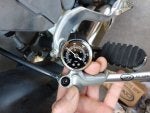Adjust the gas pressure of the rear shock.
The gas pressure for the rear suspension of ATAS with high mileage is 5~7bar (~100psi). This is not mentioned in the service manual, but in my experience, the standard value for this type of suspension is around 10bar (145psi).
The main reason for pressurizing with this gas is not to absorb the shock, but to prevent cavitation, which occurs when the oil bubbles up during operation.So there is no point in adding too much gas. Just keep the pressure within the range that will not cause cavitation.
I used a manual pump with air suspension adjustment for bicycles.
![59963 59963]()
The air valve is the same as the valve in a tire.
![59962 59962]()
Basically, it's nitrogen-filled, but since I'm only pumping for a few strokes, air is good enough 😄 80% of the atmosphere is nitrogen, and the part where air enters is a rubber balloon called a bladder. So unlike OHLINS or WP shocks, the sub-tank cylinder does not have a sliding piston wall and does not come in direct contact with the oil, so you don't have to worry about foreign matter mixing in.
If you rarely need to adjust your suspension, but feel that your suspension is overboiled pasta, or that your seat height changes before and after riding your bike, adjusting the pressure will refresh your ride.
The gas pressure for the rear suspension of ATAS with high mileage is 5~7bar (~100psi). This is not mentioned in the service manual, but in my experience, the standard value for this type of suspension is around 10bar (145psi).
The main reason for pressurizing with this gas is not to absorb the shock, but to prevent cavitation, which occurs when the oil bubbles up during operation.So there is no point in adding too much gas. Just keep the pressure within the range that will not cause cavitation.
I used a manual pump with air suspension adjustment for bicycles.
The air valve is the same as the valve in a tire.
Basically, it's nitrogen-filled, but since I'm only pumping for a few strokes, air is good enough 😄 80% of the atmosphere is nitrogen, and the part where air enters is a rubber balloon called a bladder. So unlike OHLINS or WP shocks, the sub-tank cylinder does not have a sliding piston wall and does not come in direct contact with the oil, so you don't have to worry about foreign matter mixing in.
If you rarely need to adjust your suspension, but feel that your suspension is overboiled pasta, or that your seat height changes before and after riding your bike, adjusting the pressure will refresh your ride.





